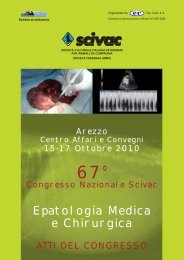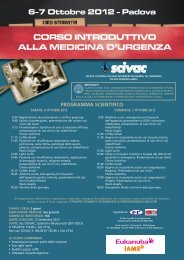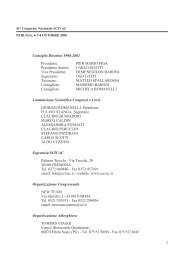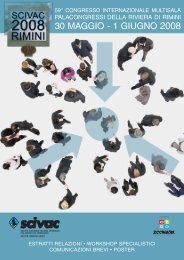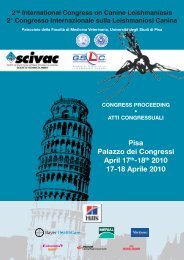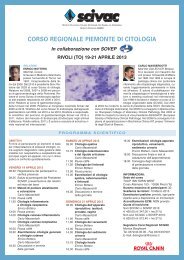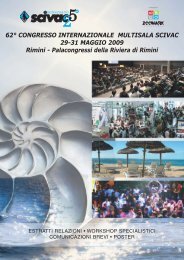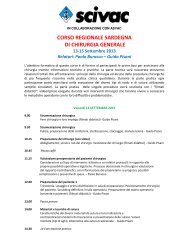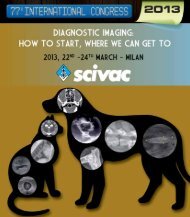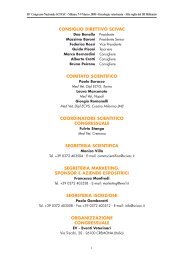68° Congresso Nazionale SCIVAC: Le domande più frequenti in ...
68° Congresso Nazionale SCIVAC: Le domande più frequenti in ...
68° Congresso Nazionale SCIVAC: Le domande più frequenti in ...
Create successful ePaper yourself
Turn your PDF publications into a flip-book with our unique Google optimized e-Paper software.
<strong>68°</strong> CONGRESSO NAZIONALE <strong>SCIVAC</strong> 11-13 Marzo 2011 - Milano<br />
LE DOMANDE PIÙ FREQUENTI IN RIPRODUZIONE CANINA E FELINA<br />
Tutto quello che i vostri clienti osano spesso chiedere e a cui voi non sapete rispondere<br />
14 th EVSSAR Congress - Advances <strong>in</strong> Fel<strong>in</strong>e Reproduction - March 11 th 2011<br />
If a neonate is severely hypothermic, it can gives warm fluids by <strong>in</strong>travenous,<br />
<strong>in</strong>traperitoneal and <strong>in</strong>traosseous routes. The temperature should never<br />
be 1 °C more than the body temperature. > 2 °C with<strong>in</strong> one hour, lifethreaten<strong>in</strong>g<br />
conditions usually results.<br />
Hypoglycemia<br />
Hypoglycemia may lead to hypothermia then to death. A variety of cl<strong>in</strong>ical<br />
signs may occur <strong>in</strong> the hypoglycaemic neonatal patient (serum glucose <<br />
0.3 g/l) <strong>in</strong>clud<strong>in</strong>g tremors, cry<strong>in</strong>g, irritability, dullness, lethargy, coma, stupor<br />
and seizures. Besides starvation and hypoxia, common causes are sepsis, poor<br />
environmental conditions, congenital metabolic defects, portosystemic shunt,<br />
... Placental <strong>in</strong>sufficiency and prematurity have been cited.<br />
The tratment consists of giv<strong>in</strong>g dextrose slowly per os (suggar water) or<br />
IV (Glucose 5%: 1 ml/25 g/d IV or IO).<br />
Dehydration<br />
Dehydration appears very quickly <strong>in</strong> neonatal patients because of their high<br />
body water content, the <strong>in</strong>ability to concentrate ur<strong>in</strong>e and the impaired ability to<br />
autoregulate renal blood flow. Other compensatory mechanisms such as <strong>in</strong>creas<strong>in</strong>g<br />
the heart rate and cardiac contractility are not well developped.<br />
The mucous membranes are best used to assess hydration and the body<br />
weight (<strong>in</strong> comparison to the littermates). At 5-7% dehydration, the mucous<br />
membranes become tacky or dry. At 10% they will be very dry and there will<br />
be very dry and there will be a noticeable decrease <strong>in</strong> sk<strong>in</strong> elasticity, and at ><br />
12% dehydration circulatory collapse occurs. The most common causes are:<br />
diarrhea, vomit<strong>in</strong>g, pneumonia, decrease milk <strong>in</strong>take and excessive ambiant<br />
temperatures.<br />
In very mild cases of dehydration, fluids may be given orally provided that<br />
gut sounds are heard. In mild cases, fluids will be absorbed slowly without<br />
overload<strong>in</strong>g the homeostatic system: 180 ml/kg/24 h (water with dextrose)<br />
orally and 1 ml/30 g subcutaneously. However, ideally, fluids should be given<br />
<strong>in</strong>travenously or <strong>in</strong>traosseously.<br />
The ma<strong>in</strong>tenance fluid requirements of the neonate are high at 80-100<br />
ml/kg/day. However the total volumes given are small because volume overload<br />
can quickly ensue: 3-4 ml/kg/h.<br />
84



